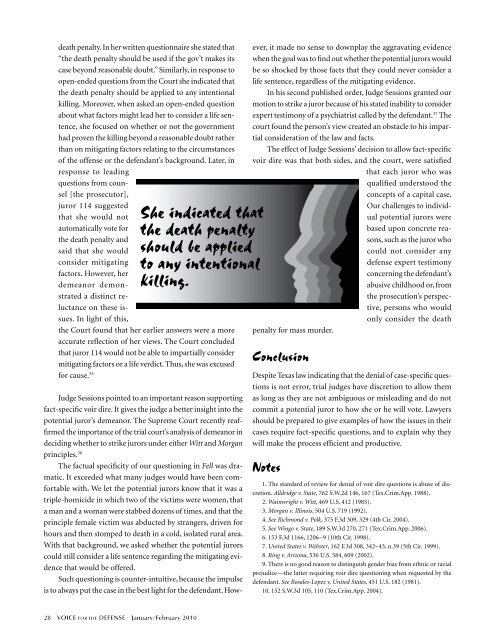for the defense for the defense - Voice For The Defense Online
for the defense for the defense - Voice For The Defense Online
for the defense for the defense - Voice For The Defense Online
Create successful ePaper yourself
Turn your PDF publications into a flip-book with our unique Google optimized e-Paper software.
death penalty. In her written questionnaire she stated that<br />
“<strong>the</strong> death penalty should be used if <strong>the</strong> gov’t makes its<br />
case beyond reasonable doubt.’’ Similarly, in response to<br />
open-ended questions from <strong>the</strong> Court she indicated that<br />
<strong>the</strong> death penalty should be applied to any intentional<br />
kill ing. Moreover, when asked an open-ended question<br />
about what factors might lead her to consider a life sentence,<br />
she focused on whe<strong>the</strong>r or not <strong>the</strong> government<br />
had proven <strong>the</strong> killing beyond a reasonable doubt ra<strong>the</strong>r<br />
than on mitigating factors relating to <strong>the</strong> circumstances<br />
of <strong>the</strong> of fense or <strong>the</strong> defendant’s background. Later, in<br />
response to leading<br />
questions from counsel<br />
[<strong>the</strong> prosecutor],<br />
ju ror 114 suggested<br />
that she would not<br />
au to mat i cally vote <strong>for</strong><br />
<strong>the</strong> death penalty and<br />
said that she would<br />
con sider miti gat ing<br />
fac tors. However, her<br />
de meanor dem onstrated<br />
a dis tinct reluc<br />
tance on <strong>the</strong>se issues.<br />
In light of this,<br />
She indicated that<br />
<strong>the</strong> death penalty<br />
should be applied<br />
to any intentional<br />
kill ing.<br />
<strong>the</strong> Court found that her earlier answers were a more<br />
ac cu rate reflection of her views. <strong>The</strong> Court concluded<br />
that ju ror 114 would not be able to impartially consider<br />
mit i gat ing factors or a life verdict. Thus, she was excused<br />
<strong>for</strong> cause. 35<br />
Judge Sessions pointed to an important reason supporting<br />
fact-specific voir dire. It gives <strong>the</strong> judge a better insight into <strong>the</strong><br />
potential juror’s demeanor. <strong>The</strong> Supreme Court recently re affirmed<br />
<strong>the</strong> importance of <strong>the</strong> trial court’s analysis of demeanor in<br />
deciding whe<strong>the</strong>r to strike jurors under ei<strong>the</strong>r Witt and Morgan<br />
principles. 36<br />
<strong>The</strong> factual specificity of our questioning in Fell was dramatic.<br />
It exceeded what many judges would have been com<strong>for</strong><br />
ta ble with. We let <strong>the</strong> potential jurors know that it was a<br />
triple-homicide in which two of <strong>the</strong> victims were women, that<br />
a man and a woman were stabbed dozens of times, and that <strong>the</strong><br />
principle female victim was abducted by strangers, driven <strong>for</strong><br />
hours and <strong>the</strong>n stomped to death in a cold, isolated rural area.<br />
With that background, we asked whe<strong>the</strong>r <strong>the</strong> potential ju rors<br />
could still consider a life sentence regarding <strong>the</strong> mitigating evidence<br />
that would be offered.<br />
Such questioning is counter-intuitive, because <strong>the</strong> impulse<br />
is to always put <strong>the</strong> case in <strong>the</strong> best light <strong>for</strong> <strong>the</strong> defendant. How‐<br />
pen alty <strong>for</strong> mass murder.<br />
Conclusion<br />
ever, it made no sense to downplay <strong>the</strong> aggravating evidence<br />
when <strong>the</strong> goal was to find out whe<strong>the</strong>r <strong>the</strong> potential jurors would<br />
be so shocked by those facts that <strong>the</strong>y could never consider a<br />
life sentence, regardless of <strong>the</strong> mitigating evidence.<br />
In his second published order, Judge Sessions granted our<br />
mo tion to strike a juror because of his stated inability to consider<br />
ex pert testimony of a psychiatrist called by <strong>the</strong> defendant. 37 <strong>The</strong><br />
court found <strong>the</strong> person’s view created an obstacle to his im partial<br />
consideration of <strong>the</strong> law and facts.<br />
<strong>The</strong> effect of Judge Sessions’ decision to allow fact-specific<br />
voir dire was that both sides, and <strong>the</strong> court, were satisfied<br />
that each juror who was<br />
qual i fied understood <strong>the</strong><br />
concepts of a capital case.<br />
Our challenges to in di vidual<br />
potential jurors were<br />
based upon concrete reasons,<br />
such as <strong>the</strong> juror who<br />
could not consider any<br />
de fense expert testimony<br />
con cern ing <strong>the</strong> defendant’s<br />
abu sive child hood or, from<br />
<strong>the</strong> prosecution’s per spective,<br />
persons who would<br />
only consider <strong>the</strong> death<br />
Despite Texas law indicating that <strong>the</strong> denial of case-specific questions<br />
is not error, trial judges have discretion to allow <strong>the</strong>m<br />
as long as <strong>the</strong>y are not ambiguous or misleading and do not<br />
com mit a potential juror to how she or he will vote. Lawyers<br />
should be prepared to give examples of how <strong>the</strong> issues in <strong>the</strong>ir<br />
cases re quire fact-specific questions, and to explain why <strong>the</strong>y<br />
will make <strong>the</strong> process efficient and productive.<br />
Notes<br />
1. <strong>The</strong> standard of review <strong>for</strong> denial of voir dire questions is abuse of discre<br />
tion. Alldridge v. State, 762 S.W.2d 146, 167 (Tex.Crim.App. 1988).<br />
2. Wainwright v. Witt, 469 U.S. 412 (1985).<br />
3. Morgan v. Illinois, 504 U.S. 719 (1992).<br />
4. See Richmond v. Polk, 375 F.3d 309, 329 (4th Cir. 2004).<br />
5. See Wingo v. State, 189 S.W.3d 270, 271 (Tex.Crim.App. 2006).<br />
6. 153 F.3d 1166, 1206–9 (10th Cir. 1998).<br />
7. United States v. Webster, 162 F.3d 308, 342–43, n.39 (5th Cir. 1999).<br />
8. Ring v. Arizona, 536 U.S. 584, 609 (2002).<br />
9. <strong>The</strong>re is no good reason to distinguish gender bias from ethnic or racial<br />
prejudice—<strong>the</strong> latter requiring voir dire questioning when requested by <strong>the</strong><br />
de fendant. See Rosales-Lopez v. United States, 451 U.S. 182 (1981).<br />
10. 152 S.W.3d 105, 110 (Tex.Crim.App. 2004).

















